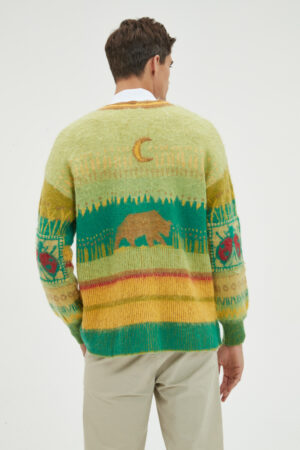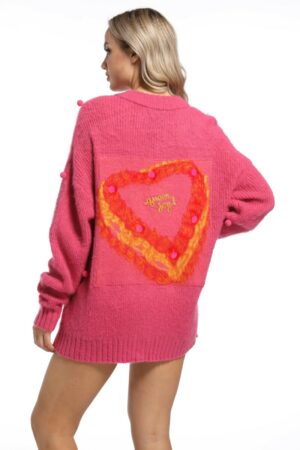Mohair fiber has a smooth, silky touch to it. It is less itchy than sheep wool. Although some people with sensitive skin find Mohair uncomfortable, it is still gentler than other wool fibers. If you learn that you are allergic to mohair, avoid the temptation to purchase or wear it. Life is too short to spend time thinking about uncomfortable attire.
To make mohair knitwear less scratchy, turn it inside out and soak it for 15 minutes in cold water, making sure that all the fibers are well soaked. Drain. Massage a liberal quantity of hair conditioner into the fibers of the sweater while it is still wet.
Is mohair itchy to wear?
Because of its coarse fibers, some people may react to mohair and feel itchy. If you are allergic to natural fibers such as wool, mohair may irritate. Wool allergies are rare, but if you believe you have one, see your doctor immediately. This is the same if you are wearing a brushed mohair knitted piece or a mohair blend knitwear.
Is kid mohair itchy?
Mohair fibers can be itchy, but it depends on the method of spinning. While mohair is a naturally softer fiber than wool, some people do not tolerate itchiness. Additionally, the fiber from older goats tends to itch more than that from the fine kid variety. So, if you are looking for a less itchy mohair yarn, you should look for kid mohair yarn.
Is Brushed Mohair Itchy?
Brushed mohair can feel sticky because it’s often blended with silk. While some brands may have a slightly itchy finish, the better brands will only collect natural hair that sheds, and this is a way to prevent it from getting itchy. Compared to other kinds of wool, brushed mohair is less likely to be itchy.
Are mohair and acrylic blend itchy?
Mohair acrylic blend fibers can be itchy, but it depends on the method of spinning. While some brands may have a slightly itchy finish, the better brands will only collect natural mohair that sheds, and this is a way to prevent it from getting itchy. Acrylic is a synthetic fiber that is often used as a substitute for wool or mohair because it is less expensive and can be made to look like natural fibers. Acrylic fibers are generally not itchy.
Is faux mohair itchy?
Faux mohair is not made from the hair of an Angora goat, but rather from synthetic fibers that are made to look like natural fibers. Synthetic fibers are generally not itchy.
Is 100% mohair itchy?
100% mohair is not itchy but also it does not exist for sweaters or jumpers.
Mohair has scales that are flat. Unlike wool, which may be ‘prickly,’ mohair is very smooth to the touch. This property also implies that mohair does not irritate the skin as much as other wool types do (with the exception of Merino wool and a few others), making it a better option for those with sensitive skin.
Is all mohair itchy?
Whether mohair is itchy depends on the person. If you are allergic to natural fibers such as wool, mohair may be itchy to you. Some individuals are unable to endure it. Look for “kid mohair” or “baby mohair,” which has finer and more delicate fibers than regular mohair. Consider knitwear made of mohair blended with other fibers such as silk or cashmere to experience a softer and more comfortable mohair fabric.
Is there non itchy mohair yarn?
It varies on the individual if mohair is itchy. Not all mohair is the same; certain varieties are inherently softer and less scratchy than others. For most individuals, kid mohair, fux mohair, or mohair acrylic blend yarn is less itchy, or non-itchy.
Is mohair itchier than wool?
Mohair, unlike other wool kinds (with the exception of Merino wool and a few others), does not itch the skin as much.
Why is mohair itchy?
Mohair, animal, and human hairs all have one characteristic: they are scratchy and hurt the skin. Mohair, like hair, bounces and does not flatten or bend when worn. It splits easily, resulting in broken ends that irritate the skin. Mohair has scales that are flat. Unlike wool, which may be ‘prickly,’ mohair is very smooth to the touch.
Can mohair cause sneezing?
In reality, knitting mohair, cashmere, and even wool causes serious issues for some individuals. Wheezing, hives, sneezing, and itching eyes are common symptoms.
Also, if you sneeze over mohair, it can be caused by dust mite allergy instead of mohair allergy. A dust mite is a small white bug (but not an “insect”) that can only be seen using a microscope.
How do you stop mohair from itching?
Here are some suggestions for making mohair less itchy:
- Use a specific detergent to clean.
- Shampoo and conditioner should be used.
- The mohair item should be steamed.
- Make use of mustard powder.
- Solution of Vinegar and Salt
- Ammonia with baking soda
- Glycerin should be used.
- Mohair should be frozen.
- Attempt a different mohair kind.
You can read more of our suggestions from this guide.
Can you be allergic to mohair?
Mohair, like other animal fibers, is typically quite pleasant in terms of health and safety, and allergic reactions to it are uncommon, however there are occasionally problems. Itching to mohair may not always indicate an allergy to it.
What does a mohair allergy look like?
Mohair allergy symptoms can include itching, redness, and hives. In some cases, people may experience more severe symptoms such as difficulty breathing or anaphylaxis. Severe allergic reactions can include:
- Severe skin itchiness resulting in rashes, sometimes blisters
- Eyes irritation, redness, and puffiness
- Consecutive sneezing resulting in a runny nose
- Swollen and red face and body parts exposed to the fabric
- Difficulty breathing due to narrowing airways
- Dropping blood pressure
- Asthma attack
- Sinusitis
- Ears and lung infections and inflammation
How to stop mohair allergic reactions?
- If you think you may be allergic to mohair, you should avoid contact with the fiber.
- Remove the Mohair clothes or fabric as soon as the reaction begins or avoid it entirely.
- If you start sneezing and coughing, use an antihistamine.
- You should visit a doctor if you see swelling in the regions of your face and body that have been exposed to mohair.
- If you start having trouble breathing, get medical attention right away.
- If you notice that mohair or wool irritates your skin, discontinue using them. Your sensitivity may worsen if you continue to wear or come into touch with the cloth.






